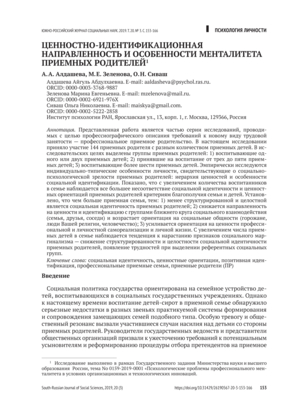Abstract
The article is one in the series of the research aimed at analyzing requirements for a new type of work called professional adoptive parenthood. 144 adoptive parents took part in the research. For the analysis, they were placed in three groups according to a number of adopted children: AP1) raising one or two foster children; AP2) three to five children and AP3) raising more than six foster children. Different techniques were used to find out the individual and the typical features of adoptive parents that testify to their socio-psychological maturity based on the hierarchy of family values and on social identification specifics. It was found out that the more adoptive children there are in the family the greater is the discrepancy between social identity and value orientations of the adoptive parents and meeting the requirements underlying the criteria of family and children’s welfare. In the course of the analysis the authors established some regularity. 1) The larger the adoptive family is the less structured and integral the social identity of the foster parents is; 2) value and identification orientation towards the nearest circle of social interaction (family, friends and neighbors) decreases, while it increases towards large social communities (city dwellers, religious groups and humanity at large); 3) orientation towards professional values and personal self-realization is enhanced. With the growth of the number of foster children in adoptive families there grows social marginality, i. e. family structure and the integrity of the adoptive parents’social identity weaken, which causes problems in their identification of reference social groups.
Keywords
Funding information
The research was carried out as a government assignment, topic No 0159-2019-0001.
References
Алдашева, А.А., Зеленова, М.Е., Понамарева, Е.А., Рунец, О.В. (2017). Ценностно-смысловые ориентации у социальных воспитателей. В А.Л. Журавлёв, В.А. Кольцова Фундаментальные и прикладные исследования современной психологии: результаты и перспективы развития (c. 2164–2173) М.: Изд-во «Институт психологии РАН».
Алдашева, А.А., Зеленова, М.Е. (2017). Профессиональный менталитет приемных родителей как фактор успешности замещающей семьи. Вестник Университета Российской академии образования, 5, 23–29.
Борневассер, М. (1993). Социальная структура, идентификация и социальный контакт. Иностранная психология, 1(1), 68–72.
Горева, О.М., Осипова, Л.Б., Сербина, Е.А. (2015). Проблемы социального сиротства в современной России. Современные проблемы науки и образования, 1–1. Режим доступа http://www.science-education.ru/ru/article/view?id=18234.
Даудрих, Н.И. (2000). Социальная идентичность: методический аспект. Социологические исследования, 13, 77–95.
Ермолаева, Е.П. (2015). Идентификационные аспекты профессиональной приемной семьи. Интернет-журнал «Мир науки», 4. Режим доступа http://mir-nauki.com/PDF/18PSMN415.pdf
Иванова, Н.Л. (2006). Проблема психологического анализа социальной идентичности. Журнал Высшей школы экономики. Психология, 3(4), 14–38.
Карпов, А.В. (2015). Психология деятельности. В 5 т.Т. V: Качественная гетерогения организации. М.: РАО.
Мисник, Л. (2018). Родителей выбирают небрежно: систему опеки ждут реформы. Газета.ru. Режим доступа https:// www.gazeta.ru/social/2018/08/16/11898325.shtml.
Нартова-Бочавер, С.К., Бочавер, К.А., Бочавер, С.Ю. (2011). Жизненное пространство семьи: объединение и разделение. М.: Генезис.
Ожигова, Л.Н. (2006). Психология гендерной идентичности личности. Краснодар: Кубанский гос. ун-т.
Розум, С.И. (2007). Психология социализации и социальной адаптации человека. СПб.: Речь.
Рябикина, З.И. (2007). Личность как субъект бытия и со-бытия. В П.Н. Ермакова, В.А. Лабунская (ред.) Психология личности: учебное пособие (с. 132–166). М.: Эксмо.
Фанталова, Е.Б. (1996). Методика «Уровень соотношения «ценности» и «доступности» в различных жизненных сферах». Журнал практического психолога, 2, 32–37.
Шеффер, Б., Шледер, Б. (2008). Социальная идентичность и групповое сознание как медиаторы межгруппового поведения. В Л.Д. Шнейдер (сост.) Идентичность: Хрестоматия (c. 170–195). М.: Изд-во МПСИ; Воронеж: НПО «МОДЭК».
Шнейдер, Л.Б. (2007). Личностная, гендерная и профессиональная идентичность. Теория и методы диагностики. Учебно-методическое пособие. М.: МПСИ.
Ядов, В.А. (1995). Социальные и социально-психологические механизмы формирования социальной идентичности личности. Мир России, 3–4, 158–181.
Abrams, D., & Hogg, M.A. (2001). Collective Identity: Group Membership and Self-Conception. In M.A. Hogg & R.S. Tindale (Eds), Blackwell Handbook of Social Psychology: Group Processes (pp. 425–460). Oxford, UK: Blackwell.
Adams, J.M., & Jones, W.H. (1997). The Conceptualisation of marital Commitment: An Integrative Analysis. Journal of Social and Personal Relationships, 11, 1177–1196.
Ainswort, M.D. (1962). The Effects of Maternal Deprivation a Revive of Finding and Controversy in the Context of Research Strategy. In Deprivation of Maternal Care: a Reassessment of its Effects (pp. 87–195) WHO. Geneva.
Bowldy, J. (1988). Defensive Processes in Response to Stressful Situation in Early Life. In E.J. Anthony, C. Chiland (Eds.) The Child and his Family: Periling Development: Child Raising and Identity Formation under stress. New York: Wiley.
Edwards, R., McCarthy, J.R. (2011). Key Concepts of Family Studies. SAGE Publications of London, Thousand Oaks.
Edwards, R., Ribbens, McCarthy, J., Gillies, V. (1999). Biolojical parents and social families: Legal discourses and everyday understandings of the position of stepparants. International Journal of Law, Policy and the Famamily, 13, 78–105.
Gergen K. (2001). Social Construction in Context. London: Sage.
Hogg, M.A. (1992). The Social Psychology of Group Cohesiveness: From Attraction to Social Identity. London: Harvester Wheatsheaf.
Hogg, M.A. (2000). Social Identity and Social Comparison. In J. Suls & L. Wheeler (eds), Handbook of Social Comparison: Theory and Research (pp. 401–421). New York: Kluwer/Plenum.
Kelley H.H., Thibaut J.W. (1959). The Social Psychology of Groups. N.Y.: John Wiley & Sons.
Schäfer, B. & Schlöder, B. (1990). National-bewußtsein als Aspekt sozialer Identität. In P. Leidinger & D. Metzler (Hrsg.), Geschichte und Geschichtsbewußtsein. Festschrift Karl-Ernst Jeismann zum 65. Geburtstag (pp. 309–348). Münster: Institutfür Didaktik der Geschichte.
Schäfer, B. & Schlöder, B. (1994). Identitätund Fremdheit. Sozialpsychologische Aspekte der Eingliederung und Ausgliede-rung des Fremden. Jahrbuch für Christliche Sozialwissenschaft, 35, 69–87.
Tajfel H. (1981). Human Groups and Social Categories: Studies in Social Psychology. Cambridge, England: Cambridge University Press.
Tajfel H. (1968). Social and Cultural Factors in Perception. In G. Lindzey, E. Aronson (Eds.). The Handbook of Social Psychology. Reading.
Turner J.C., Hogg M.A., Oakes P.J. et al. (1987). Rediscovering the Social Group. A Selfcategorization Theory. Oxford & New York: Blackwell.
Turner, J. (1986). The Structure of Sociological Theory, 4th ed. Homewood. IL: Dorsey
Turner, J.H. and J.E. Stets. (2005). The Sociology of Emotions. New York: Cambridge University Press.
Verkuyten M. (2005). The Social Psychology of Ethnic Identity. Hove, NY.


